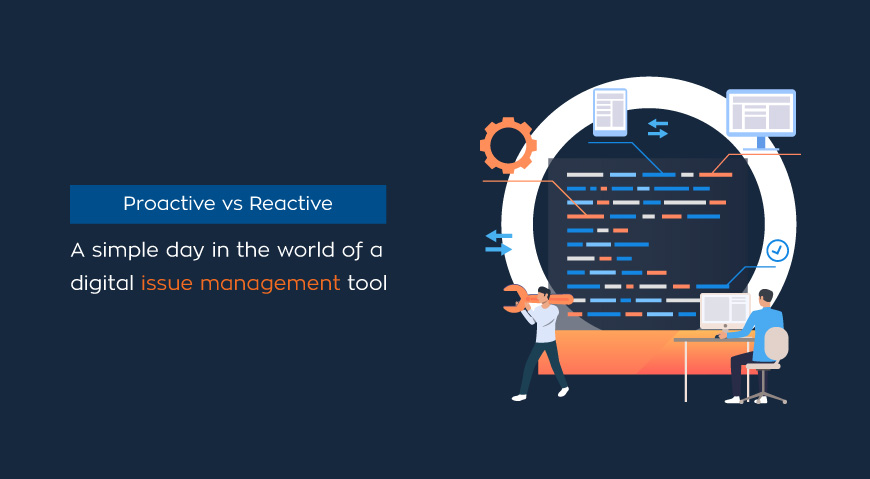Proactive vs Reactive: A simple day in the world of a digital issue management tool
It can be said that many abstractions can be linked to the perceived need in companies to use increasingly sophisticated technologies. Among them is rapid market growth and this forces businesses to adapt. It looks like these speeds won’t be standardized anytime soon, so the question easily arises:
Is it easy to follow them?
One of the main ways is to ask companies to create the right mechanisms to be proactive instead of reactive, which leads us to conclude that identifying, acting on, and ultimately resolving incidents is an important step in this direction.
4 reasons to move to an IM tool
Issue management software is designed to help organizations identify, track, and resolve issues. There are a number of reasons why organizations might need such a solution, some of which include:
Improved communication:
An issue management software can help improve communication between the various stakeholders involved in issue resolution. By providing a centralized communication platform, stakeholders can update the status of issues and collaborate more effectively to resolve them.
Faster Resolution time:
By providing real-time visibility into the status of issues and enabling collaboration among stakeholders, organizations can identify and resolve issues before they become major problems.
Digital issues management solutions can provide organizations with detailed reporting and analytics, allowing them to identify trends and areas for improvement. This can help organizations proactively identify and address problems before they become serious problems.
Regulatory compliance:
Many industries are subject to regulatory requirements related to issue management. Such solutions can help organizations ensure compliance with these requirements by providing a centralized platform to track and document issues.
Overall, a digital issue management solution can help organizations better manage and solve the problems they face, resulting in increased efficiency, faster resolution times, and better collaboration across teams. Stakeholders.
If you look closely, the common thread across all 4 on the list is emphasizing the importance of organizations being able to take the initiative, fully understand, and address problems before they become major problems. What are the main assets to achieve this?
3 key IM features
QR-Patrol adds to basic workforce management functions as a comprehensive issue management tool with the following key features:
Real-time incident management reports:
This software enables field personnel to report incidents in real-time through a user-friendly application environment, including detailed information on the nature of the incident, location, and stakeholders. This can help the security team respond more effectively to incidents and take appropriate action to prevent future incidents.
Workflow management:
This software provides workflow and workflow management tools related to physical security incidents. This includes assigning tasks to team members, tracking progress, setting deadlines, and prioritizing tasks. This feature can help streamline the incident response process and ensure tasks are completed on time.
Reporting and Analysis:
Features that help teams better understand incident data, such as incident frequency, response times, and root cause analysis, are a great proactive tool for teams to identify trends, make data-driven decisions, and improve overall security.
Proactive vs Reactive
Of course, issue management software offers a number of advantages over older methods of recording incidents, which often involve the use of paper or spreadsheet forms. Some of the main differences are:
Efficiency:
Issue management software streamlines the incident recording process by providing a digital platform for incident creation, monitoring, and management. This saves time and effort compared to manually filling out paper forms or spreadsheets.
Proactive solutions that respect the environment:
Each incident can be reported much faster using a cloud-based, real-time system, and resolution workflows can be started at the same time as reporting, avoiding the use of pen & paper and any environmental impact it may have.
Collaboration:
Multiple users can collaborate on issues in real-time, allowing for faster communication and more efficient problem resolution. In contrast, extensive spreadsheets and pen & paper methods record incidents based on physical forms that only one user can view at a time.
Accessibility:
It provides a centralized database of incident logs that can be accessed from anywhere, as long as there is an internet connection while using traditional reporting methods, which often involve physical logs records are stored in one location and can be difficult to access.
Reporting and Analysis:
The powerful reporting and analysis tools provided can help organizations better understand their incident data, identify trends, and make data-driven decisions. Otherwise, the process of combining data to generate insights can be both time-consuming and nearly impossible most of the time.
Our experts can help you choose the right tool for your operations and provide training where needed; contact us for a free consultation at info@usnatek.com or use our live chat (during working hours from 09:00 AM to 06:00 PM). Also, check out our blog for more.

